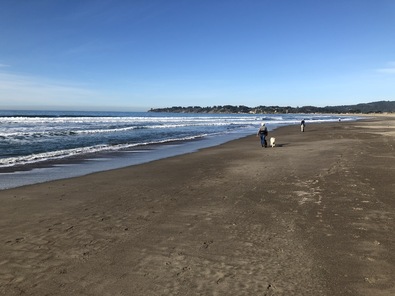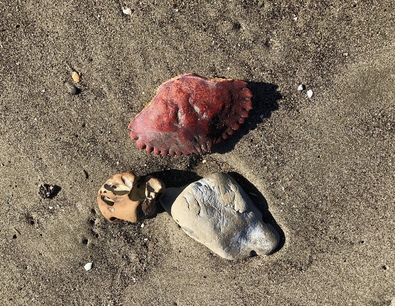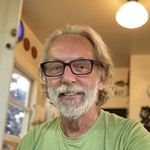February 5, 2023

 On Friday, my friend Chuck and I were on our way to Stinson Beach (north of San Francisco) for a leisurely luncheon and walk along the beach with some friends. Just before we arrived, I got a call from Stanford. Stanford tried calling me three times on my car phone as we were driving along, but I’ve never used my car phone so I ignored the calls thinking they were spam. That is, until Chuck said, “Answer it! Whoever it is wouldn’t keep calling you back if it wasn’t important. Maybe it's Stanford.” Then, Chuck showed me how to answer my car phone by pressing the green button on my car dashboard. Duh! In fact, it was Stanford finally calling me because they had just gotten all the authorization forms for me to proceed with CAR-T. Thank you Chuck!
On Friday, my friend Chuck and I were on our way to Stinson Beach (north of San Francisco) for a leisurely luncheon and walk along the beach with some friends. Just before we arrived, I got a call from Stanford. Stanford tried calling me three times on my car phone as we were driving along, but I’ve never used my car phone so I ignored the calls thinking they were spam. That is, until Chuck said, “Answer it! Whoever it is wouldn’t keep calling you back if it wasn’t important. Maybe it's Stanford.” Then, Chuck showed me how to answer my car phone by pressing the green button on my car dashboard. Duh! In fact, it was Stanford finally calling me because they had just gotten all the authorization forms for me to proceed with CAR-T. Thank you Chuck!
Stanford had a last minute cancellation and made an appointment for me to discuss CAR-T at 2:30 that afternoon. It was already past 11 am and we were almost at Stinson Beach. Yikes! I didn’t want to pass up this window of opportunity, so… Rush, rush, rush. Instead of a leisurely lunch and walk along the beach, Chuck and I got to Stinson Beach, quickly said hello and goodbye to our friends, then headed back to the East Bay.
I dropped Chuck off at his house in Albany, picked up some paperwork at my home in Berkeley, then headed off to Palo Alto. It usually takes at least an hour and a half to get from my house to Stanford. More rushing, but I did make it in time. At Stanford, I got to meet with my new CAR-T oncologist, her nurse practitioner, and a Stanford fellow. Besides reviewing what would be involved, signing copious consent forms, having blood drawn to check for possible infectious diseases, I also had to have my veins evaluated to see if I needed a picc-line (I don’t). After all that, I was formally approved for CAR-T. I’m now on board to start CAR-T therapy as soon as I can get a couple issues resolved. The initial extraction of my T-cells would likely be the end of February/early March. Then, I'd be put on an interim chemo regimen while waiting a month or so for the bioengineered T-cells to be sent back and then reintroduced back into me. That’s when my hospitalization would start and would last ~2 weeks. After that, I’m to stay nearby the Stanford hospital for 1-4 weeks depending on how I do.
To get the CAR-T ball rolling, I first need to work on getting 24/7 caretakers for when I’m released from the hospital and need to stay nearby. Having a caretaker is mandatory, and could range from a week to a month of my staying nearby Stanford -- likely in late March or April. Stanford will cover lodging and meals -- although that’s yet to be finalized when I talk with the Stanford social worker early next week. When I talk with her, I'll need to get a few logistic and other information sorted out so I can be clear with potential caregivers what’s involved. I’ve already had some offers from friends to help out with caretaking, and my friends Karla and Karen have both offered to help coordinate caretakers. The start date for the caretaking part still isn’t set in stone and the timetable partly rests on how long it will take for the company to bioengineer and return my T-Cells. The nurse practitioner told me that I should try to limit caretaking to friends who are local for a couple reasons. Since the dates aren't firm as to when they will be needed, it’s better to have local friends who don’t have to arrange to fly here at the last minute. The other reason is that those friends who are far away and would need to fly here might need to stay in quarantine for ~5 days. This was especially evident yesterday when my cousin Pam from New Hampshire flew here with her daughter Tris who wanted to come out and see the redwoods. After their hikes in Muir Woods, we were planning to get together on my deck with masks and taking antigen tests before we got together. However, at the last minute, Tris tested positive for COVID so we ended up doing FaceTime instead of physically getting together. We don't know if the positive COVID result was from the flight, the airports or some other situation. My cousin is a nursing professor and was totally supportive of being extra cautious now that I'm so close to the start-line for CAR-T.
The other issue is more problematic. I have to decide which of two CAR-T manufacturing products I want to go with: Acbema or Carvkti. Each has comparable risks of “Cytokine storm”, neurotoxicity and secondary cancers. Carvkti has an additional risk (10%) of irreversible Parkinson’s symptoms. These two versions also differ in how long they are effective. Acbema is an average of 9-10 months, Carvitki is an average of 2+ years. Because both are new treatments (Carvkti was just approved in late November), there isn’t a lot of data comparing the two or knowing long-term outcomes for either one.
I’ve been reaching out to various sources (my oncologist, UCSF, local myeloma support group, online patient discussions) to add to what my Stanford doctor went over regarding these two choices. Maybe too much knowledge isn’t always a good thing. My oncologist reiterated that Carvkti has shown a longer duration (2 years) compared to Acbema (9 months), but Carvkti has higher risks and death rate. He told me: “Tough decision. Whichever one you make will be the right one for you.” Hmmm. Interestingly, this is the first time I’ve heard of anyone having a choice of which treatment to go with. Everyone else I’ve talked with or heard about is assigned one or the other depending on what the institution has available. Another patient told me how fortunate I was to have a choice. Well, I guess so. I could also flip a coin.
Stinson Beach is in Marin County, about 20 miles north of San Francisco. These photos are from a year ago.
News and Updates from Paul
